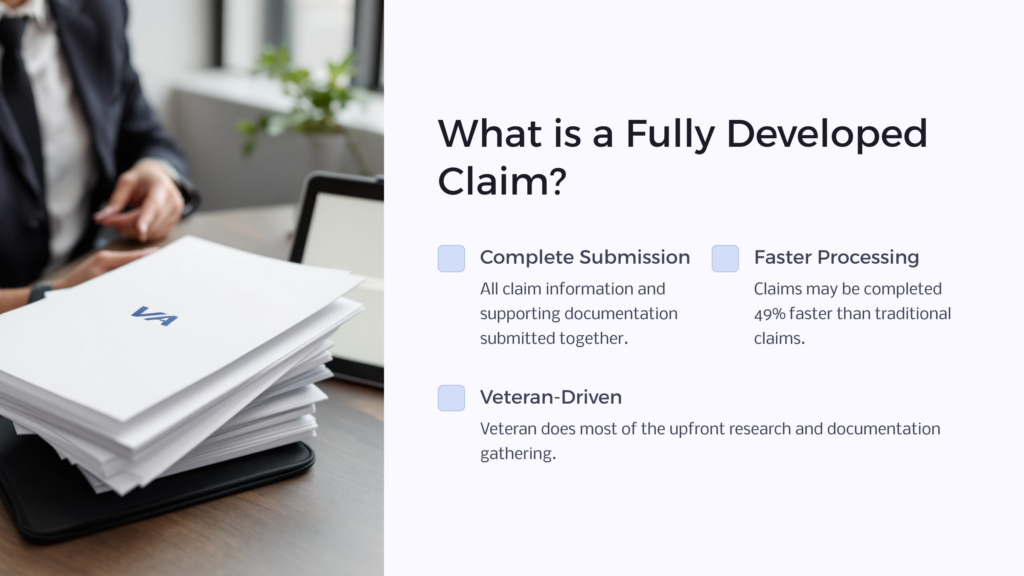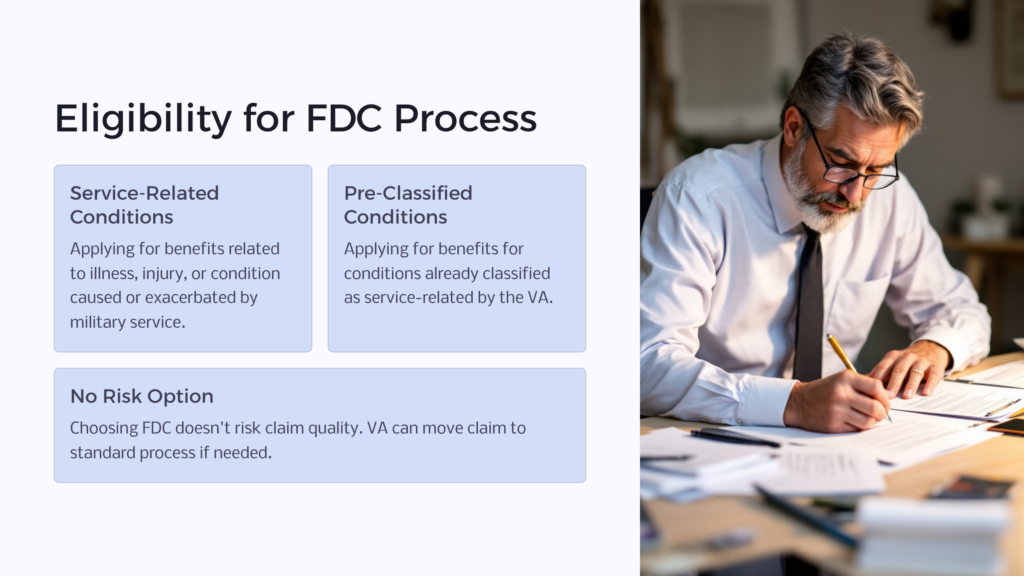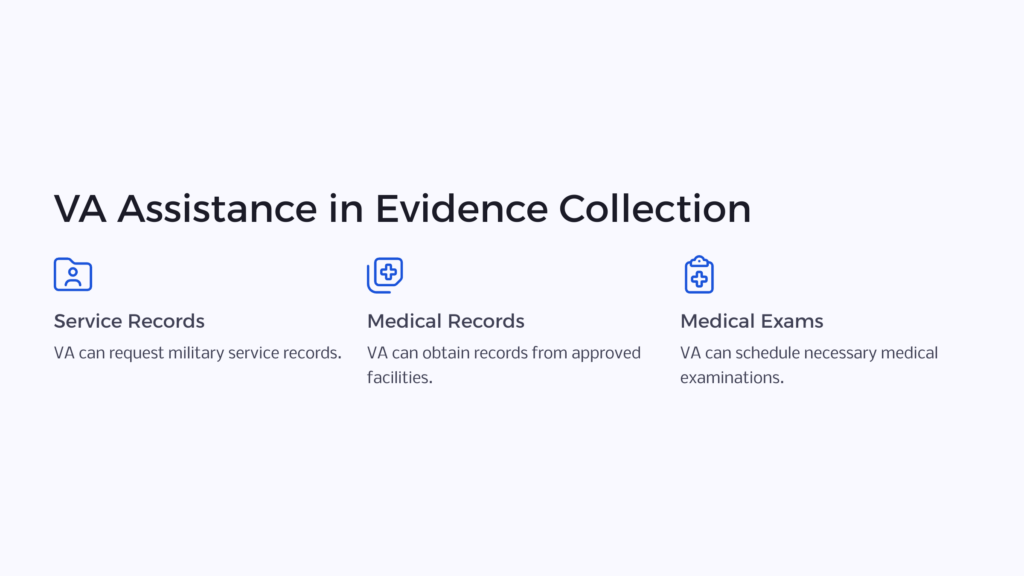In the United States, the Department of Veterans Affairs provides a Fully Developed Claim program. The process allows you to submit your VA disability claim information all at once for a faster response than if you applied through the traditional route. The fully developed claim program lets the VA approve applications that are well-supported and in good order more quickly than those whose documentation trickles in over time.
While a fully developed claim may not be right for everyone, it can significantly reduce the wait time for approval if you’re willing to put in the work on the front end. We’ll go through all the steps you need to know about in order to be prepared.
7 Steps of the Fully Developed Claim Process
- Applicant Information
- Military Service History
- Disability Records
- Treatment Records
- Special Circumstances
- Supporting Documents
- Final Review & Submission
Begun in 2010, the Fully Developed Claims program is a fast-track method to submit your VA disability claim for review in hopes that you’ll also receive a much faster answer. The FDC program was developed to address the serious backlog of pending claims for disability compensation throughout the nation, and the FDC process represents roughly half of all VA disability claims submitted today.
While a fully developed claim is much more work on the disabled veteran on the front end, the extra effort does appear to be worth it. Data from previous years has indicated that fully developed claims may be completed an average of a full 49% faster than all other disability claims. You can complete a fully developed claim online, in person at a regional office, or with the help of a Veterans Service Officer or other trained professional. A qualified VSO can help you gather all appropriate medical documentation and help you file your initial claim.
What Is a Fully Developed Claim?

A fully developed claim is submitted in its entirety after the veteran has done most of the upfront research. Instead of formally filing a claim and then following the claim with supporting documentation, everything associated with a fully developed claim is submitted all at the same time. This differs from the regular claim approval process since the veteran does most of the work to track down all appropriate documentation rather than the VA.
Once you begin your FDC claim, you will have one full year to complete it and provide all documentation requested. If and when your FDC claim is approved, your disability back pay will be retroactive back to the day you filed your claim.
It’s important to note that if you submit your claim and then follow up with additional information or medical documentation, your claim will be removed from the fully developed claim process and subjected to a regular VA disability review.

- Your claim is eligible for the fully developed claim process if it meets the following criteria:
- You’re applying for veterans disability benefits related to an illness, injury, or medical condition that either was caused by or exacerbated by your military service
- You’re applying for benefits related to a medical condition that the VA has already classified as service-related
There is no risk to you for choosing to submit a fully developed claim rather than a traditional claim. The VA takes the same level of care and thoughtful attention for all fast-tracked claims. If at any point in the FDC process the VA determines that it needs additional, non-federal information to appropriately assess your claim, it will simply remove your file from the fully developed claim process and move it to the standard process. But if your claim is appropriate for the fully developed claim process, you could get a decision in as few as 90 days, with an average of 136 days for getting a ruling.
7 Steps in the VA Disability Claim Process
There are seven distinct portions of the fully developed claim. Each portion of the FDC process must be fully addressed. Let’s take a closer look now at each of the steps associated with completing and submitting a fully developed claim. You’ll need to submit thorough documentation and evidence for each of these areas.
1. Applicant Information
Your claim starts with submitting your basic applicant information, and the easiest way to start your claim is online at eBenefits.va.gov. The VA also recommends that you work with a qualified VSO as you work through the fully developed claim process.
Once you log into your account, you’ll be taken to your personal dashboard, where you can select that you’d like to apply for benefits and then choose veterans disability benefits as the type. This is also where you can designate a VSO to serve as your representative to gather and submit the appropriate information. You’ll also need to verify that you understand all the privacy disclosures inherent in the FDC process.
2. Military Service History
You’ll need to submit all documentation you have that outlines your active duty service history, including both military medical and personnel records. Within the online system, you can enter your periods of military service. These are non-editable once submitted, so make sure to verify what you’re entering against all your military service records. Also, make sure to answer every question under both the Service Information and Military Pay sections before continuing to the rest of the FDC application.
3. Disability Records
In this section of the FDC process, you will choose whether you’re applying for VA disability benefits related to a new disability or whether you would like to request an increased disability rating or disability benefit amount related to a condition the VA has previously classified as service-related. You also may request the VA to reopen and grant an additional review to a disability claim the VA previously reviewed and found not to be service-related. You can also choose the option to add a secondary condition that you believe was irritated or exacerbated by your service-related disability or medical condition.
In addition to formal medical evidence, you also can include letters from family, friends, clergy, co-workers that can help provide VA reviewers with a comprehensive picture of your medical condition and how it affects your ability to earn a living. Your primary physician can complete the VA benefits questionnaire included in this portion of the FDC process.
4. Treatment Records
 Once you’ve entered all the disability conditions you’d like to be considered, it’s time to share your medical treatment history. The first question you need to answer is whether you’ve received any medical treatment at a VA medical center. If the answer is, “no,” you’ll skip to the Special Circumstances section, but if you answer, “yes,” you will move on to provide all the information about your medical treatment as prompted by the system.
Once you’ve entered all the disability conditions you’d like to be considered, it’s time to share your medical treatment history. The first question you need to answer is whether you’ve received any medical treatment at a VA medical center. If the answer is, “no,” you’ll skip to the Special Circumstances section, but if you answer, “yes,” you will move on to provide all the information about your medical treatment as prompted by the system.
This is where it’s extremely important to be thorough. Your VA examiner will place a lot of weight on the medical evidence you provide that supports your claim. For this section, it’s better to provide too much information than too little, so try to track down every single treatment record you can. This includes treatment reports from your family doctor, copies of X-rays or other imaging reports, all records of any test results, plus any records you retained from the military that outline any treatment for your service-related condition.
You will need to provide documentation of any related health records that you don’t currently have in your possession, but that the VA can request from a VA-facilitated medical facility. While this section asks you simply to answer questions and provide information about your medical treatment, you also will have the opportunity to attach all other supporting evidence once you advance to the Supporting Documents portion of the FDC process.
5. Special Circumstances
If you indicate that you did not receive any medical treatment at a VA medical center, the application system will automatically bump you to this Special Circumstances section. Here, you will be able to select additional compensation benefits with your claim. The system will guide you through specific questions to ensure you’re submitting what the VA reviewers need in order to make a decision about your claim.
6. Supporting Documents
Under this section, you will be able to attach and submit all supporting documentation in your possession that can lend strength to your VA claim. It bears repeating that it’s important to be thorough, so don’t hesitate to attach a document if you believe it has a chance of strengthening your claim. In truth, it’s this step of the FDC process that allows your claim to be submitted as fully developed, since you’re sending all appropriate medical evidence at the same time, rather than asking the VA to collect medical documentation on your behalf.
7. Final Review & Submission
Before you submit your fully developed claim, you will have a chance to review everything you’ve submitted to check for both accuracy and completion. It’s important to take your time and carefully review what the system shows for you.
Once you’ve submitted your information, you will not have further opportunity to revise it – you’ll simply check the option for Fully Developed Claim and submit your information. At this point, you should see a confirmation screen advising that your information has successfully been submitted and you will get a confirmation number.
What Evidence Will I Need to Submit a Claim?
The evidence you submit for a fully developed claim is no different from what you would submit for the standard claim review process. All medical evidence and documentation will need to support two major conclusions.
First, that you are currently suffering from a permanent medical condition or illness that renders you unable to earn a living. Second, your evidence must show that this claimed condition is directly related to an injury, illness, or medical condition you suffered as a direct result of your military service. Appropriate types of evidence include statements from physicians, test results, X-rays, and other medical imaging results.
Can the VA Help Me Collect Evidence?

Yes, absolutely. With your permission, the VA can complete the following on your behalf:
- Request all military service records
- Request all relevant Social Security benefits information and medical records from VA-approved facilities
- If needed for your review, request a medical opinion from a health care provider
- Schedule necessary medical exams
Fully Developed Claim Process
While it certainly comes with its pros and cons, choosing to submit your VA disability claim through the fully developed claim process could literally pay dividends. It’s extra work on the front end, but also brings with it a higher chance of being accepted earlier in the process.

Not too long ago, the American Legion reported that 4% of all VA disability claims it assisted with were submitted through the fully developed claim process, and 90% of them were approved upon first review. If you’re willing to put in the front-end work, and you have trusted and qualified help, it’s worth reviewing your VA claim to determine whether this is the right path for you.
 Benefits.com Advisors
Benefits.com Advisors
With expertise spanning local, state, and federal benefit programs, our team is dedicated to guiding individuals towards the perfect program tailored to their unique circumstances.
Rise to the top with Peak Benefits!
Join our Peak Benefits Newsletter for the latest news, resources, and offers on all things government benefits.


















